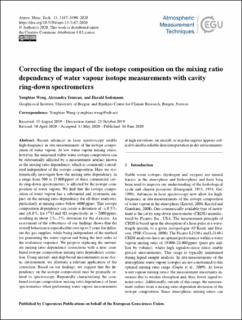| dc.contributor.author | Weng, Yongbiao | |
| dc.contributor.author | Touzeau, Alexandra | |
| dc.contributor.author | Sodemann, Harald | |
| dc.date.accessioned | 2021-04-12T09:34:42Z | |
| dc.date.available | 2021-04-12T09:34:42Z | |
| dc.date.created | 2020-09-23T20:34:26Z | |
| dc.date.issued | 2020 | |
| dc.Published | Atmospheric Measurement Techniques. 2020, 13 3167-3190. | |
| dc.identifier.issn | 1867-1381 | |
| dc.identifier.uri | https://hdl.handle.net/11250/2737262 | |
| dc.description.abstract | Recent advances in laser spectroscopy enable high-frequency in situ measurements of the isotope composition of water vapour. At low water vapour mixing ratios, however, the measured stable water isotope composition can be substantially affected by a measurement artefact known as the mixing ratio dependency, which is commonly considered independent of the isotope composition. Here we systematically investigate how the mixing ratio dependency, in a range from 500 to 23 000 ppmv of three commercial cavity ring-down spectrometers, is affected by the isotope composition of water vapour. We find that the isotope composition of water vapour has a substantial and systematic impact on the mixing ratio dependency for all three analysers, particularly at mixing ratios below 4000 ppmv. This isotope composition dependency can create a deviation of ±0.5 ‰ and ±6.0 ‰ for δ18O and δD, respectively, at ∼2000 ppmv, resulting in about 2 ‰–3 ‰ deviation for the d-excess. An assessment of the robustness of our findings shows that the overall behaviour is reproducible over up to 2 years for different dry gas supplies, while being independent of the method for generating the water vapour and being the first order of the evaluation sequence. We propose replacing the univariate mixing ratio dependency corrections with a new, combined isotope composition–mixing ratio dependency correction. Using aircraft- and ship-based measurements in an Arctic environment, we illustrate a relevant application of the correction. Based on our findings, we suggest that the dependency on the isotope composition may be primarily related to spectroscopy. Repeatedly characterising the combined isotope composition–mixing ratio dependency of laser spectrometers when performing water vapour measurements at high elevations, on aircraft, or in polar regions appears critical to enable reliable data interpretation in dry environments. | en_US |
| dc.language.iso | eng | en_US |
| dc.publisher | Copernicus | en_US |
| dc.rights | Navngivelse 4.0 Internasjonal | * |
| dc.rights.uri | http://creativecommons.org/licenses/by/4.0/deed.no | * |
| dc.title | Correcting the impact of the isotope composition on the mixing ratio dependency of water vapour isotope measurements with cavity ring-down spectrometers | en_US |
| dc.type | Journal article | en_US |
| dc.type | Peer reviewed | en_US |
| dc.description.version | publishedVersion | en_US |
| dc.rights.holder | Copyright the authors 2020. | en_US |
| cristin.ispublished | true | |
| cristin.fulltext | original | |
| cristin.qualitycode | 1 | |
| dc.identifier.doi | 10.5194/amt-13-3167-2020 | |
| dc.identifier.cristin | 1832753 | |
| dc.source.journal | Atmospheric Measurement Techniques | en_US |
| dc.source.40 | 13 | |
| dc.source.pagenumber | 3167-3190 | en_US |
| dc.relation.project | Notur/NorStore: NS9054K | en_US |
| dc.relation.project | Norges forskningsråd: 245907 | en_US |
| dc.relation.project | Norges forskningsråd: 262710 | en_US |
| dc.identifier.citation | Atmospheric Measurement Techniques. 2020, 13 (6), 3167-3190. | en_US |
| dc.source.volume | 13 | en_US |
| dc.source.issue | 6 | en_US |

